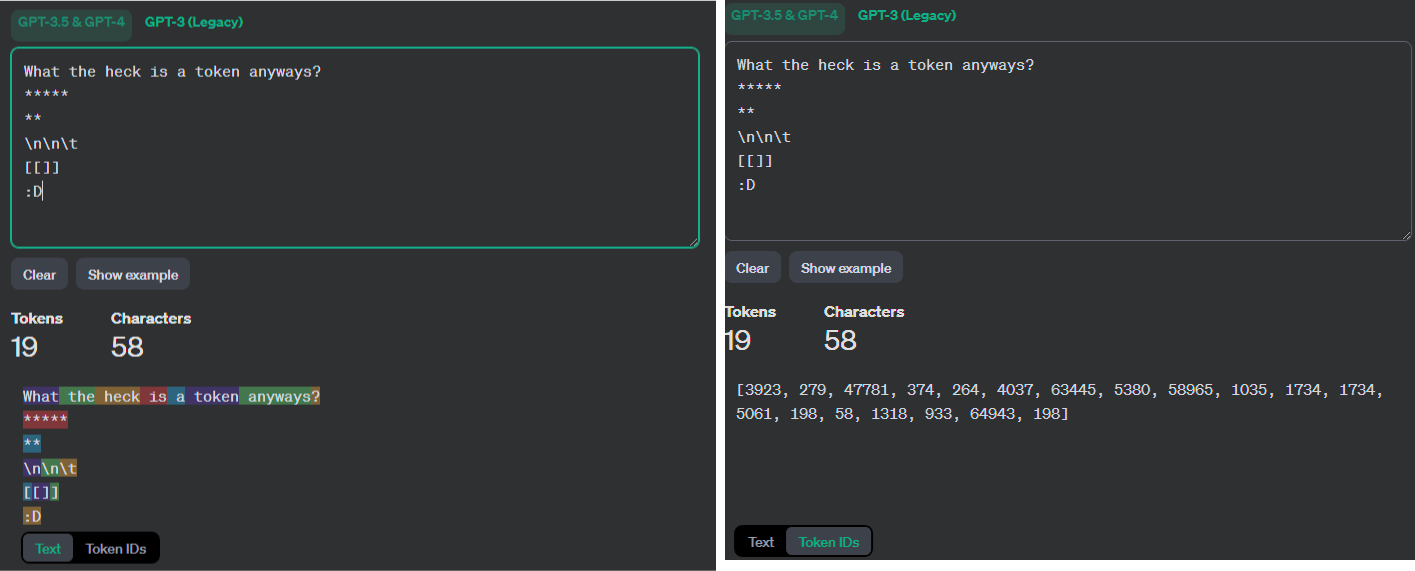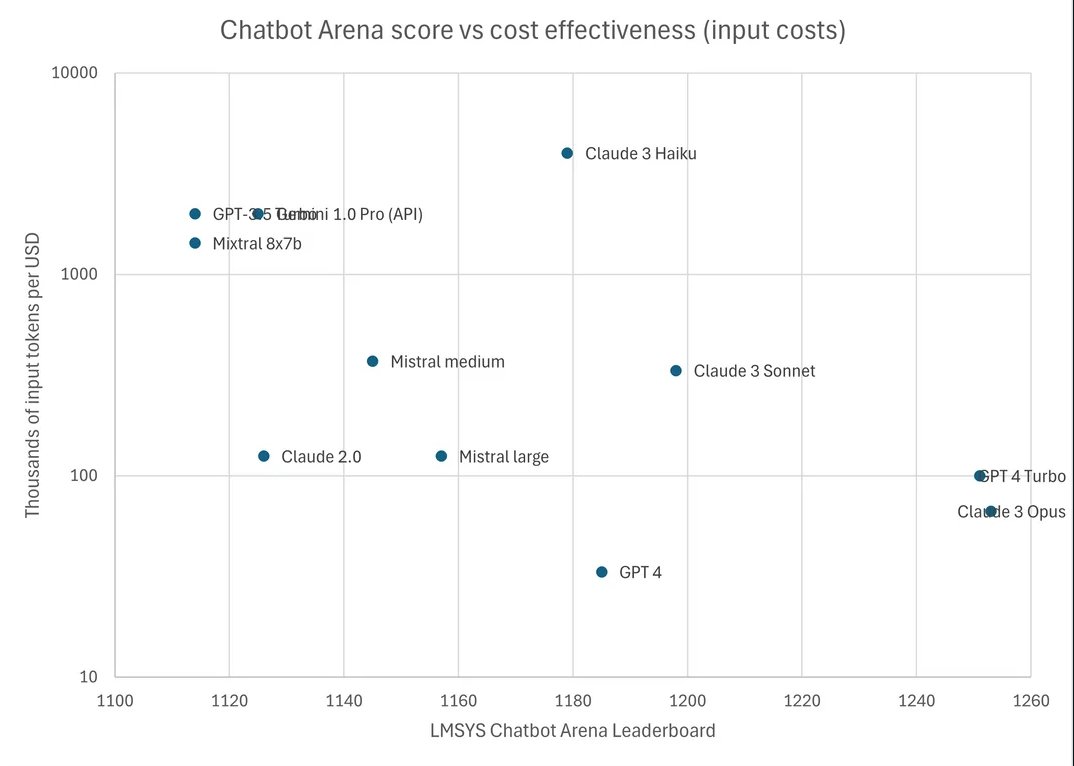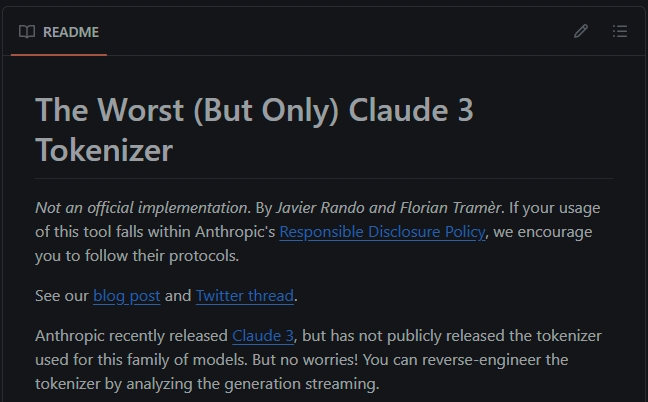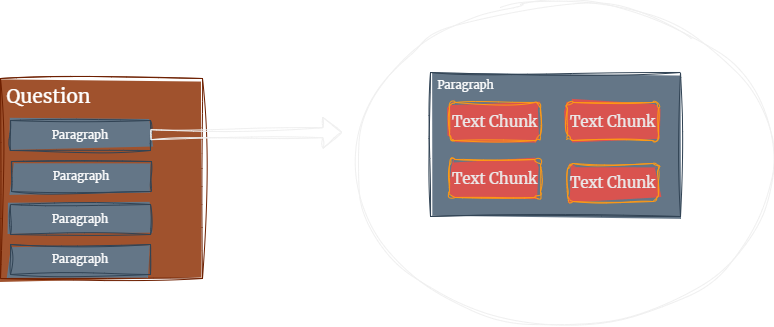Code
with jsonlines.open(musique_dir + '/data/musique_full_v1.0_train.jsonl') as reader:
lines = [reader.read() for _ in range(1000)]
display(Markdown('**Line Example**'), pprint(lines[1])){'answer': 'north',
'answer_aliases': ['North', 'N'],
'answerable': True,
'id': '2hop__269805_135710',
'paragraphs': [{'idx': 0,
'is_supporting': False,
'paragraph_text': 'Milton F. Pavlic (1909–1942) was a United '
'States Navy officer killed in action '
'during World War II for whom a U.S. Navy '
'high-speed transport was named.',
'title': 'Milton F. Pavlic'},
{'idx': 1,
'is_supporting': False,
'paragraph_text': 'Osmund Holm-Hansen (also known as Oz '
'Holm-Hansen) is a Norwegian-born American '
'scientist, for whom Mount Holm-Hansen, in '
'Antarctica is named. A plant physiologist '
'by training, from 1962 Holm-Hansen was the '
'head of polar research at the Scripps '
'Institution of Oceanography.',
'title': 'Osmund Holm-Hansen'},
{'idx': 2,
'is_supporting': False,
'paragraph_text': '"Sapphire Princess" was built in Japan by '
'Mitsubishi Heavy Industries, the second '
'Princess Cruises ship to be built in a '
'Japanese shipyard. Her only sister ship is '
'"Diamond Princess", with whom she swapped '
'names during construction.',
'title': 'Sapphire Princess'},
{'idx': 3,
'is_supporting': False,
'paragraph_text': 'Lake Pontchartrain is named for Louis '
'Phélypeaux, comte de Pontchartrain. He was '
'the French Minister of the Marine, '
'Chancellor, and Controller-General of '
"Finances during the reign of France's "
'"Sun King", Louis XIV, for whom the colony '
'of "La Louisiane" was named.',
'title': 'Lake Pontchartrain'},
{'idx': 4,
'is_supporting': False,
'paragraph_text': 'Henry Crater is a large crater in the '
'Arabia quadrangle of Mars, located at '
'10.9° north latitude and 23.3° east '
'longitude. It is in diameter and was named '
'after the brothers Paul Henry and Prosper '
'Henry, both of whom were French telescope '
'makers and astronomers.',
'title': 'Henry (Martian crater)'},
{'idx': 5,
'is_supporting': False,
'paragraph_text': 'Where Dead Voices Gather is a book by Nick '
'Tosches. It is, in part, a biography of '
'Emmett Miller, one of the last minstrel '
'singers. Just as importantly, it depicts '
"Tosches' search for information about "
'Miller, about whom he initially wrote in '
'his book "Country: The Twisted Roots of '
'Rock and Roll". It is also a study of '
'minstrelsy and its connection to American '
'folk music, country music, the blues and '
'ultimately, rock and roll. In that way, it '
'is a companion volume to his other books '
'of music journalism, "Country" and "Unsung '
'Heroes of Rock N\' Roll".',
'title': 'Where Dead Voices Gather'},
{'idx': 6,
'is_supporting': True,
'paragraph_text': 'Norway has a total area of and a '
'population of 5,312,300 (as of August '
'2018). The country shares a long eastern '
'border with Sweden (1,619 km or 1,006\xa0'
'mi long). Norway is bordered by Finland '
'and Russia to the north-east, and the '
'Skagerrak strait to the south, with '
'Denmark on the other side. Norway has an '
'extensive coastline, facing the North '
'Atlantic Ocean and the Barents Sea. The '
"maritime influence also dominates Norway's "
'climate with mild lowland temperatures on '
'the sea coasts, whereas the interior, '
'while colder, also is a lot milder than '
'areas elsewhere in the world on such '
'northerly latitudes. Even during polar '
'night in the north, temperatures above '
'freezing are commonplace on the coastline. '
'The maritime influence brings high '
'rainfall and snowfall to some areas of the '
'country.',
'title': 'Norway'},
{'idx': 7,
'is_supporting': False,
'paragraph_text': 'The Hireling Shepherd (1851) is a painting '
'by the Pre-Raphaelite artist William '
'Holman Hunt. It represents a shepherd '
'neglecting his flock in favour of an '
'attractive country girl to whom he shows a '
"death's-head hawkmoth. The meaning of the "
'image has been much debated.',
'title': 'The Hireling Shepherd'},
{'idx': 8,
'is_supporting': False,
'paragraph_text': 'Naissa Mosque is a mosque in Qardaha, '
'along the Syrian coast. It was built in '
'1989 by architect Abdul Rahman Naassan, '
'and funded by the mother of former '
'president Hafez al-Assad, Naissa '
'Assad—after whom the mosque was named. The '
'state funeral of Hafez al-Assad was '
'observed at the mosque.',
'title': 'Naissa Mosque'},
{'idx': 9,
'is_supporting': False,
'paragraph_text': 'The quick German victory over the French '
'stunned neutral observers, many of whom '
'had expected a French victory and most of '
'whom had expected a long war. The '
'strategic advantages possessed by the '
'Germans were not appreciated outside '
'Germany until after hostilities had '
'ceased. Other countries quickly discerned '
'the advantages given to the Germans by '
'their military system, and adopted many of '
'their innovations, particularly the '
'General Staff, universal conscription and '
'highly detailed mobilization systems.',
'title': 'Franco-Prussian War'},
{'idx': 10,
'is_supporting': True,
'paragraph_text': 'Tveitsund is a village in Nissedal '
'municipality, Norway. The urban area '
'Tveitsund, which consists of Tveitsund and '
'Treungen, has a population of 361.',
'title': 'Tveitsund'},
{'idx': 11,
'is_supporting': False,
'paragraph_text': 'John Francis Sheehan (1910–1942) was a '
'United States Navy sailor killed in action '
'during World War II for whom a destroyer '
'escort was named during the war.',
'title': 'John Francis Sheehan'},
{'idx': 12,
'is_supporting': False,
'paragraph_text': 'Holmes Summit is a peak rising to , the '
'highest elevation in the Read Mountains of '
'the Shackleton Range in Antarctica. It was '
'photographed from the air by the U.S. Navy '
'in 1967 and was surveyed by the British '
'Antarctic Survey in the period 1968–71. In '
'association with the names of geologists '
'grouped in this area, it was named by the '
'UK Antarctic Place-Names Committee in 1971 '
'after Professor Arthur Holmes, after whom '
'the Holmes Hills in Palmer Land were also '
'named.',
'title': 'Holmes Summit'},
{'idx': 13,
'is_supporting': False,
'paragraph_text': ', better known by her pen name is a '
'Japanese manga artist. She is married to '
'fellow manga artist Tatsuneko, from whom '
'he took the name of . She is a graduate of '
'Mita Senior High School, Tokyo. She '
'currently lives in Setagaya, Tokyo with '
'her husband and daughter.',
'title': 'Yun Kōga'},
{'idx': 14,
'is_supporting': False,
'paragraph_text': 'The Book of Proper Names () is a Belgian '
'novel by Amélie Nothomb. It was first '
'published in 2002. It is a romanticized '
'account of the life of the singer RoBERT, '
'whom Nothomb became acquainted with as an '
'avid admirer of her songs.',
'title': 'The Book of Proper Names'},
{'idx': 15,
'is_supporting': False,
'paragraph_text': '653 Berenike is a main-belt asteroid '
'discovered on November 27, 1907, by Joel '
'Hastings Metcalf at Taunton, '
'Massachusetts. It is named after Berenice '
'II of Egypt, after whom the constellation '
'Coma Berenices is also named.',
'title': '653 Berenike'},
{'idx': 16,
'is_supporting': False,
'paragraph_text': 'orbiting the Sun. It was discovered on 21 '
'February 1906 by August Kopff from '
'Heidelberg. Kopff named the asteroid after '
'a female English student with whom he was '
'acquainted.',
'title': '596 Scheila'},
{'idx': 17,
'is_supporting': False,
'paragraph_text': 'William M. Hobby (1899–1942), was a United '
'States Navy officer killed in action '
'during World War II for whom a U.S. Navy '
'ship was named.',
'title': 'William M. Hobby'},
{'idx': 18,
'is_supporting': False,
'paragraph_text': 'The Alma Grace McDonough Health and '
'Recreation Center is a 2,200 seat '
'multipurpose arena and recreation facility '
'on the campus of Wheeling Jesuit '
'University in Wheeling, West Virginia. The '
'building was constructed thanks to a gift '
'from Alma Grace McDonough, whom the '
'building is named after.',
'title': 'Alma Grace McDonough Health and Recreation Center'},
{'idx': 19,
'is_supporting': False,
'paragraph_text': 'Émile Bertrand (1844–1909) was a French '
'mineralogist, in honour of whom '
'bertrandite was named by Alexis Damour. He '
'also gave his name to the "Bertrand lens" '
'or phase telescope.',
'title': 'Émile Bertrand'}],
'question': 'What is the country where Nissedal is located named after?',
'question_decomposition': [{'answer': 'Norway',
'id': 269805,
'paragraph_support_idx': 10,
'question': 'Nissedal >> country'},
{'answer': 'north',
'id': 135710,
'paragraph_support_idx': 6,
'question': 'The #1 was named for whom?'}]}Line Example
None








